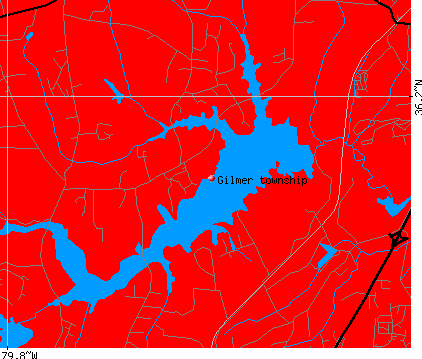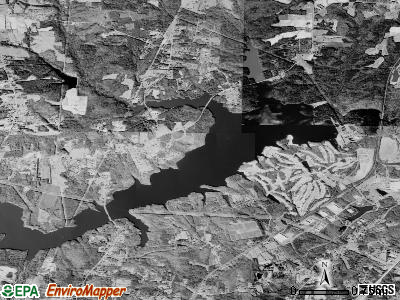Gilmer township, Guilford County, North Carolina (NC) detailed profile
Number of foreign born residents: 6 (16% naturalized citizens)
| Gilmer township: | 6.4% |
| Whole state: | 5.3% |
50% of Gilmer township residents lived in the same house 5 years ago.
Out of people who lived in different houses, 64% lived in this county.
Out of people who lived in different counties, 51% lived in North Carolina.
Place of birth for U.S.-born residents:
- This state: 41380
- Northeast: 3665
- Midwest: 1340
- South: 7471
- West: 654
Median price asked for vacant for-sale houses in 2000: $80,200
Percentage of households with unmarried partners: 5.8%
Likely homosexual households (counted as self-reported same-sex unmarried-partner households)
- Lesbian couples: 0.3% of all households
- Gay men: 0.2% of all households
People in group quarters in Gilmer township, North Carolina:
- 3,423 people in college dormitories (includes college quarters off campus)
- 621 people in nursing homes
- 195 people in other noninstitutional group quarters
- 59 people in other group homes
- 43 people in homes or halfway houses for drug/alcohol abuse
- 27 people in homes for the physically handicapped
- 16 people in homes for the mentally retarded
- 13 people in hospitals/wards and hospices for chronically ill
- 13 people in hospices or homes for chronically ill
- 12 people in homes for the mentally ill


Housing units in structures:
- One, detached: 14,616
- One, attached: 698
- Two: 1,040
- 3 or 4: 1,817
- 5 to 9: 3,329
- 10 to 19: 1,280
- 20 to 49: 668
- 50 or more: 694
- Mobile homes: 222
- Boats, RVs, vans, etc.: 8
Median worth of mobile homes: $14,300
Housing units in Gilmer township with a mortgage: 6,695 (1,210 second mortgage, 783 home equity loan, 72 both second mortgage and home equity loan)
Houses without a mortgage: 2,571
- Construction (14%)
- Accommodation and food services (7%)
- Educational services (7%)
- Administrative and support and waste management services (6%)
- Textile mills and textile products (4%)
- Other transportation, and support activities, and couriers (4%)
- Food and beverage stores (4%)
- Health care (13%)
- Educational services (13%)
- Finance and insurance (8%)
- Accommodation and food services (8%)
- Social assistance (5%)
- Administrative and support and waste management services (4%)
- Department and other general merchandise stores (4%)
- Other production occupations including supervisors (7%)
- Laborers and material movers, hand (7%)
- Driver/sales workers and truck drivers (7%)
- Building and grounds cleaning and maintenance occupations (6%)
- Material recording, scheduling, dispatching, and distributing workers (6%)
- Construction trades workers except carpenters, electricians, painters, plumbers, and construction laborers (4%)
- Other management occupations except farmers and farm managers (3%)
- Other office and administrative support workers including supervisors (7%)
- Cashiers (5%)
- Other production occupations including supervisors (5%)
- Building and grounds cleaning and maintenance occupations (5%)
- Preschool, kindergarten, elementary and middle school teachers (4%)
- Customer service representatives (4%)
- Nursing, psychiatric, and home health aides (4%)
Most common first ancestries reported in Gilmer township:
- United States or American (5.1%)
- English (2.5%)
- African (2.0%)
- German (1.5%)
- Irish (1.4%)
- Scotch-Irish (1.0%)
- Italian (0.6%)
Most common places of birth for the foreign-born residents:
- Mexico (48%)
- Vietnam (10%)
- Other Western Africa (5%)
- Nigeria (5%)
- Other Eastern Africa (4%)
- Ghana (3%)
- Africa, n.e.c. (2%)
Means of transportation to work:
- Drove a car alone: 18,052 (71%)
- Carpooled: 4,836 (19%)
- Bus or trolley bus: 815 (3%)
- Streetcar or trolley car: 7 (0%)
- Subway or elevated: 15 (0%)
- Ferryboat: 6 (0%)
- Taxi: 111 (0%)
- Motorcycle: 6 (0%)
- Bicycle: 37 (0%)
- Walked: 652 (3%)
- Other means: 273 (1%)
- Worked at home: 451 (2%)
Most commonly used house heating fuel:
- Utility gas (51%)
- Electricity (39%)
- Fuel oil, kerosene, etc. (6%)
- Bottled, tank, or LP gas (3%)
People in group quarters in Gilmer township, North Carolina:
- 3,423 people in college dormitories (includes college quarters off campus)
- 621 people in nursing homes
- 195 people in other noninstitutional group quarters
- 59 people in other group homes
- 43 people in homes or halfway houses for drug/alcohol abuse
- 27 people in homes for the physically handicapped
- 16 people in homes for the mentally retarded
- 13 people in hospitals/wards and hospices for chronically ill
- 13 people in hospices or homes for chronically ill
- 12 people in homes for the mentally ill
90.3% of residents of Gilmer township speak English at home.
6.0% of residents speak Spanish at home (41% speak English very well, 15% speak English well, 31% speak English not well, 12% don't speak English at all).
1.3% of residents speak other Indo-European language at home (63% speak English very well, 20% speak English well, 14% speak English not well, 3% don't speak English at all).
1.3% of residents speak Asian or Pacific Island language at home (37% speak English very well, 22% speak English well, 37% speak English not well, 3% don't speak English at all).
1.1% of residents speak other language at home (71% speak English very well, 20% speak English well, 5% speak English not well, 4% don't speak English at all).
Household type by relationship:
Households: 54,282- In family households: 43,488 (7,447 male householders, 6,335 female householders)
7,361 spouses, 15,923 children (14,730 natural, 429 adopted, 764 stepchildren), 2,018 grandchildren, 972 brothers or sisters, 548 parents, 1,375 other relatives, 1,509 non-relatives
- In nonfamily households: 10,794 (3,979 male householders (3,073 living alone)), 4,629 female householders (3,944 living alone)), 2,186 nonrelatives
- In group quarters: 4,356 (515 institutionalized population)
Size of family households: 5,482 2-persons, 3,680 3-persons, 2,533 4-persons, 1,255 5-persons, 499 6-persons, 333 7-or-more-persons,
Size of nonfamily households: 7,017 1-person, 1,254 2-persons, 223 3-persons, 65 4-persons, 31 5-persons, 7 6-persons, 11 7-or-more-persons,
5,338 married couples with children.
6,694 single-parent households (819 men, 5,875 women).
Private vs. public school enrollment:
Students in private schools in grades 1 to 8 (elementary and middle school): 110
| Here: | 1.7% |
| North Carolina: | 8.2% |
Students in private schools in grades 9 to 12 (high school): 102
| Here: | 3.1% |
| North Carolina: | 6.9% |
Students in private undergraduate colleges: 1,093
| Here: | 17.4% |
| North Carolina: | 20.2% |